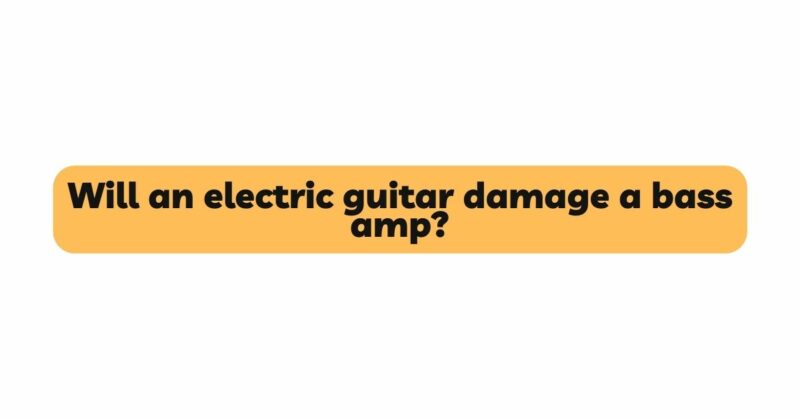The world of music is a vast and interconnected landscape, with instruments often sharing amplification equipment in a quest for unique sounds and creative exploration. One question that frequently arises is whether using an electric guitar with a bass amplifier or vice versa poses a risk of damage to the equipment. In this article, we delve into the intricacies of the electric guitar and bass amplifier relationship, investigating the compatibility, potential risks, and safeguards musicians should consider when crossing these sonic boundaries.
The Role of Amplification:
Amplification is a cornerstone of modern music production, allowing instruments to be heard clearly in live performances and recordings. Electric guitars and bass guitars are no exception, requiring amplification to project their distinctive tonal characteristics to an audience. However, the interplay between these instruments and their respective amplifiers requires careful examination to ensure compatibility and avoid unintended consequences.
Electric Guitar and Bass Amplifiers: Understanding the Differences
Electric Guitar Amplifiers: Electric guitar amplifiers are designed to accentuate and project the unique tonal qualities of electric guitars. They focus on the mid and high frequencies, providing the overdrive, distortion, and tonal shaping that complement the guitar’s melodic and harmonic elements.
Bass Amplifiers: Bass amplifiers are engineered to cater to the lower frequency range produced by bass guitars. Their design emphasizes the deep and resonant tones that anchor the rhythm section of a musical composition. Bass amps prioritize clarity, power, and the ability to reproduce low frequencies accurately.
Compatibility and Risk Assessment:
When contemplating whether an electric guitar can potentially damage a bass amplifier (or vice versa), several key factors come into play:
Frequency Response: The primary concern with using an electric guitar through a bass amplifier or vice versa is the frequency response mismatch. Electric guitars generate mid and high frequencies that align with guitar amp characteristics, while bass guitars produce deeper and lower frequencies that align with bass amp attributes. Playing an electric guitar through a bass amplifier might result in a lack of clarity and an absence of tonal dynamics.
Power Handling: Bass amplifiers are typically built to handle the increased power demands of bass frequencies, ensuring accurate reproduction without distortion. Plugging an electric guitar into a bass amplifier may not pose an immediate risk, but pushing the amp to its limits with high-gain settings might result in speaker damage over time.
Clipping and Distortion: When pushing a bass amplifier with an electric guitar signal, the amp’s circuitry might experience clipping or distortion due to the lower frequency content of the guitar signal. Clipping occurs when an amplifier attempts to amplify a signal beyond its capacity, leading to sonic artifacts and potential damage to the amplifier and speakers.
Speaker Consideration: The difference in frequency ranges can lead to strain on speakers not designed to handle certain frequencies. Bass amplifiers are equipped with speakers that can withstand the demands of low frequencies, while guitar amplifiers prioritize mid and high frequencies. Plugging a bass guitar into a guitar amplifier might overexert the speaker, leading to damage or reduced lifespan.
Tonal Quality: Crossing equipment boundaries can lead to a compromised tonal quality. Plugging an electric guitar into a bass amp might result in a lack of definition and punch, while using a bass guitar through a guitar amp could lead to muddiness and tonal distortion.
Mitigating Risks and Achieving Compatibility:
While using an electric guitar with a bass amplifier (or vice versa) presents certain challenges, there are measures that musicians can take to achieve compatibility and minimize risks:
Limit High-Gain Settings: When using a bass amplifier for an electric guitar, avoid using high-gain settings that might strain the amplifier’s circuitry.
External EQs and Effects: Employ external equalizers and effects pedals to shape the signal before it reaches the amplifier. This allows for a more controlled tonal output that aligns with the amplifier’s characteristics.
Blending and Monitoring: In a live performance setting, consider using a dedicated amplifier for each instrument, utilizing the bass amp for the bass guitar and the guitar amp for the electric guitar. Use additional monitors for proper monitoring without compromising the sonic integrity.
Speaker Choice: Selecting appropriate speaker cabinets that complement the instrument’s frequency range can improve the overall compatibility and sonic output.
Modelling Amplifiers: Digital modelling amplifiers often offer settings for both electric guitar and bass. Utilizing these presets can provide a safer platform for experimenting with different instruments.
Conclusion:
The question of whether an electric guitar can damage a bass amplifier, or vice versa, is complex and dependent on various factors. While there are inherent risks associated with using equipment beyond its design parameters, musicians can take precautionary measures to achieve compatibility and safeguard their gear.
Creative experimentation is a hallmark of musical evolution, and while there might be instances where blending electric guitars and bass amplifiers yields interesting sonic results, understanding the equipment’s limitations and potential risks is crucial. Musicians should approach these endeavors with a blend of curiosity and caution, utilizing their knowledge to push boundaries while respecting the integrity of their instruments and amplification equipment.


